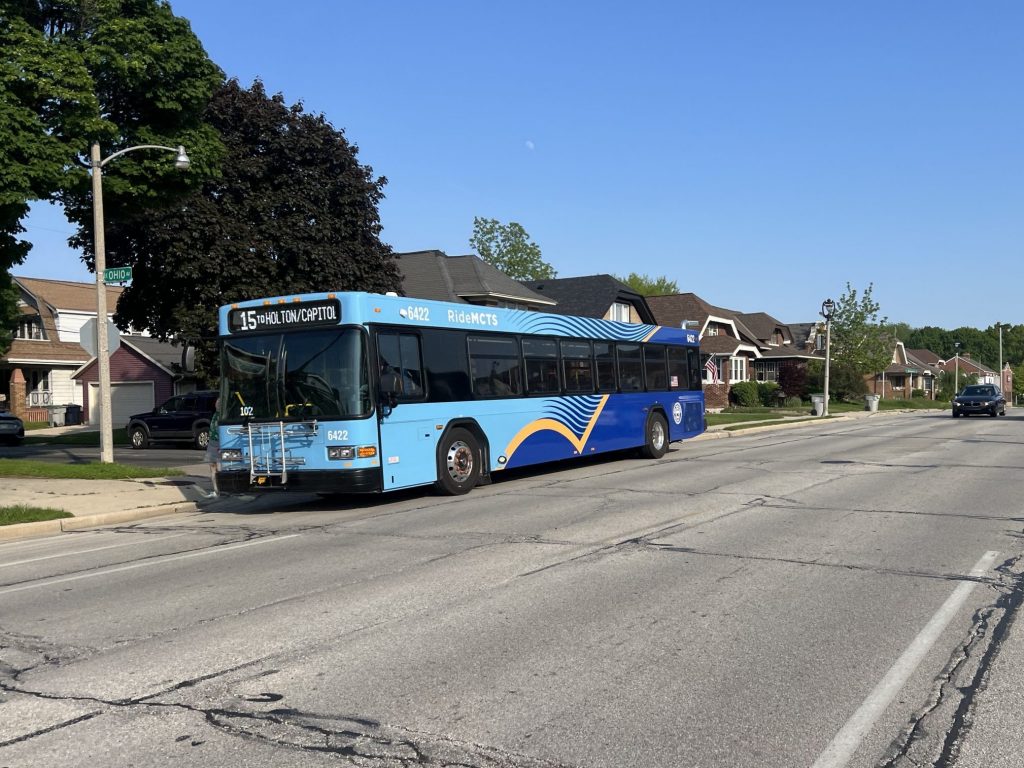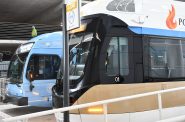MCTS Won’t Solve Budget Woes By Making Service Worse
Proposed service cuts are symptom of larger problem for county bus system.

MCTS Bus. Photo by Jeramey Jannene.
Milwaukee County Transit System (MCTS) is facing a $10.9 million budget deficit and their plan to close the gap is to cut back on the systems core, frequent routes. According to recent announcements, MCTS will reduce 20,000 service hours this fall, largely by scaling back off-peak and Saturday trips on its highest-frequency, most productive routes. No routes will be eliminated, but that’s hardly reassuring. Riders don’t take comfort in knowing a bus technically still exists if it now comes only a couple of times an hour.
These are not just unfortunate cuts, they’re a symptom of a deeper problem. MCTS seems more focused on preserving a map than preserving a system. There’s a difference. When the priority is to maintain geographic coverage at all costs, frequency suffers. And when frequency suffers, ridership declines. It’s a death spiral we’ve seen before.
Even more concerning is the way this budget crisis emerged. We are now halfway through the year, and the public (and even county officials) are just now learning of a $10.9 million shortfall. That’s not a routine midyear adjustment. That’s a serious governance failure, prompting the County Board to order a full audit of MCTS’s governance and oversight structure. If the agency wants to be trusted with dedicated funding, transparency and accountability must come first.
This retreat from frequency is especially troubling because it directly contradicts the vision MCTS laid out just a few years ago during the MCTS NEXT redesign. At that time, the agency committed to rebalancing the system around high-ridership corridors, improving frequency, and making transit more useful for more people. It was a bold move that recognized quality over quantity. What we’re seeing now is the opposite: a return to the old habit of doing a little bit of everything and doing none of it well.
Through MCTS NEXT, the agency conducted broad public engagement and heard clearly: riders wanted more frequent bus service. MCTS delivered—briefly. But at the first sign of financial trouble, that frequency is the first thing on the chopping block. That sends the message that public input only matters when it’s convenient.
MCTS is currently developing a three-year strategic plan, the first of its kind in decades, which may help make the case for how dedicated funding could improve transit service. But this won’t be the last financial challenge the agency faces. And if the response to this crisis is any indication, MCTS appears willing to set aside its stated values and the needs of its riders in the name of political expedience.
Transit agencies elsewhere have shown that investing in frequent, high-quality service can build both ridership and public support. When agencies concentrate resources where demand is strongest and deliver service people can rely on, they create momentum. And just as importantly, they create demand. People outside the core service area begin asking, “Why can’t we have that?” That’s how political will for expansion and investment grows—through visible success.
MCTS could follow the same path. Delivering high-quality, high-frequency service to a smaller geographic area isn’t a retreat, it’s investing in a base of support. Riders who can count on transit will become advocates for more of it. That’s how you expand service sustainably: by proving its value, not by stretching it thin.
Instead, MCTS is signaling that reliability and frequency are optional, as long as there’s a bus somewhere. That’s a mistake. Invest where people are riding. Deliver a great product. Be honest about challenges. Build trust. Then ask for more.
Zaysha Sandwick is a long time resident of the Harambee neighborhood who is passionate about transit.
If you think stories like this are important, become a member of Urban Milwaukee and help support real, independent journalism. Plus you get some cool added benefits.
Op-Ed
-
Wisconsin Candidates Decry Money in Politics, Plan to Raise Tons of It
 Dec 15th, 2025 by Ruth Conniff
Dec 15th, 2025 by Ruth Conniff
-
Trump Left Contraceptives to Rot; Women Pay the Price
 Dec 8th, 2025 by Dr. Shefaali Sharma
Dec 8th, 2025 by Dr. Shefaali Sharma
-
Why the Common Council’s Amended Budget is Good Policy for Milwaukee
 Nov 20th, 2025 by Alds. Marina Dimitrijevic and Russell W. Stamper, II
Nov 20th, 2025 by Alds. Marina Dimitrijevic and Russell W. Stamper, II
Transportation
-
Congestion Pricing Cuts Air Pollution in New York City
 Dec 14th, 2025 by Jeff Wood
Dec 14th, 2025 by Jeff Wood
-
FTA Tells Milwaukee to Crack Down on Fare Evasion — Even Where Fares Don’t Exist
 Dec 12th, 2025 by Graham Kilmer
Dec 12th, 2025 by Graham Kilmer
-
Will GOGO’s Bus Service Ever Get Going?
 Dec 9th, 2025 by Jeramey Jannene
Dec 9th, 2025 by Jeramey Jannene




















She is 100% right. Frequency is faaaaaar more important than coverage. The most used routes should have buses pass stops so frequently that riders do not need to check a schedule when they get to their departure stop. This makes the bus far more viable for people of all income levels to ride.
The measure of a strong society is not when the wealthy own lavish automobiles, it’s when the wealthy ride public transit.
Realistically, if it were not for budget woes within the city and county, we would devote more funding to transit and high ridership routes such as 30, CN1, and Green would be streetcar/light rail, or at the BARE MINIMUM have transit only lanes. These routes are along such dense corridors that if only frequencies were better than 10/15 minutes at peak, they would have insanely well performing ridership.
This misses another overall problem. Currently the MCTS bus is always the least efficient method of transport outside of unique weather or traffic situations. MCTS has so many stops per mile and Milwaukee has so many traffic lights that can always drive a car (if they have that financial luxury) or ride a bike faster. Other cities aren’t like this around the world.
Humans will pick the most efficient method they can afford. A bus system will always struggle if the only riders are only choosing it because they can’t afford anything else. Ditch half the stops, remove a bunch of the expensive lights.
I attempted to use the city bus system while participating in the UWM Senior Audit program. I live within walking distance of two main lines for the bus system. The bus schedules were so erratic I was forced to use my car to the bus shuttle area.
And there are some bus lines, especially those running north to south, on the southside , that run twice an hour at best. Specifically, Route 92.